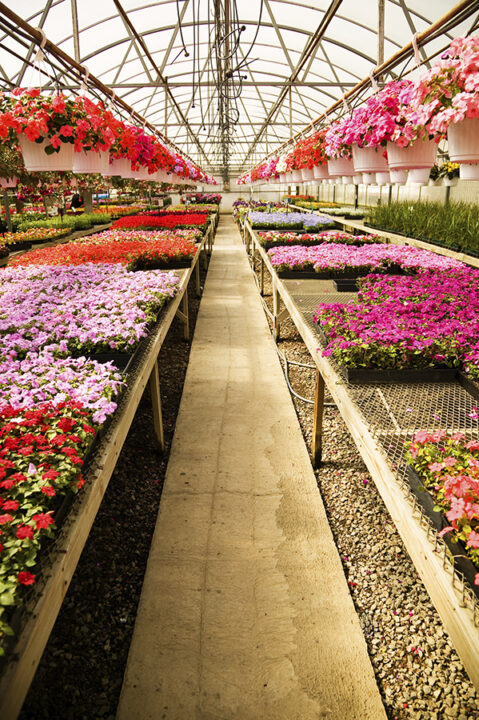Cold And Sustainable Poinsettia Production

Temperature
In response to rising energy costs over the past several years, greenhouse growers have implemented a variety of tactics to reduce energy costs, including lowering their temperature set points, increasing insulation, starting production later in the season, consolidating production, installing energy curtains, contracting fuel, purchasing energy-efficient heaters or switching to alternative fuel sources. Since many of the above strategies require substantial investments, for many poinsettia growers, the most cost-effective solution is to lower greenhouse growing temperatures. However, it is important to remember that temperature controls the rate of plant development, including time to unfold a leaf and time to flower. As the average daily temperature (ADT) decreases, the rate of development decreases and a crop is increasingly delayed. In addition, if temperatures are at or below a species-specific base temperature, the developmental rate is zero and the plant stops developing.
Poinsettias are tropical plants native to Mexico and Guatemala, and are generally considered to be a cold-sensitive crop with a base temperature of 50ËšF. According to research at Michigan State University, the growing temperature in which the least amount of energy for heating is consumed per crop depends on the species or cultivar, location and market date. Therefore, the heating cost for a cold-sensitive crop such as poinsettia could be higher if the crop is grown cold for a long time.
Cold Temperature And Sustainable Trials
In 2007, experimental trials were conducted at the Purdue University Plant-Growth Facility Greenhouses to determine which of 22 poinsettia cultivars could be successfully finished at a relatively cold day and night temperature set point and with the fewest inputs. Poinsettias were grown at 75ËšF/67ËšF day/night (ADT of 71ËšF) until the start of short days. The short-day photoperiod consisted of an 8-hour natural day achieved using blackout cloth from 8 am to 4 pm. On the start of short days, half the plants were moved into a greenhouse with a temperature set point of 65ËšF/57ËšF day/night (ADT of 61ËšF). Time to first color and anthesis (pollen shed), bract area and height data were collected for plants in each treatment. In this study, plants were considered marketable at anthesis, although certain cultivars were marketable several days to 2 weeks before anthesis, and this would affect cost saving calculations.
In order to reduce input costs and grow our crops as sustainably as possible, we incorporated several proactive strategies during the trial. Instead of using chemicals to sterilize our floors and benches, we sterilized our glass-glazed greenhouse by allowing the temperatures to rise to more than 120ËšF for 2 days (not recommended for all glazing materials, check with your greenhouse manufacturer). Long days were provided with energy-efficient, high-pressure sodium (HPS) lamps until the start of short days. Within a week of planting, Scanmask (Steinernema feltiae) nematodes were released to control fungus gnats into the media. In addition, no fungicides or growth regulators were applied to the crop during the growing season.
Responses To Cold Temperature Finishing
Table 1 shows the mean flowering responses of 14 red, white, pink and novelty poinsettia cultivars from the Ecke Ranch and Dömmen. At an ADT of 71ËšF, ‘Freedom Early Red,’ ‘Freedom Pink’ and ‘Jester Red’ had the shortest response time from the start of short days to anthesis of 54, 56 and 57 days, respectively. When the day and night temperature set point after the start of short days was lowered by 10ËšF, ‘Freedom Early Red’ and ‘Jester Red’ took an additional 2.5 and 2.7 weeks, respectively to reach anthesis. An additional 3.8 to 4.0 weeks was added to the finish time when ‘Prestige Early Red,’ ‘Merlot’ and ‘Euroglory Red’ were grown at 65ËšF/57ËšF day/ night (Figure 1). The mid-season cultivar ‘Velveteen Red’ took nearly 16 weeks to reach anthesis at an ADT of 61ËšF (Figure 2). Of the white and pink cultivars tested, all were delayed by 4.4 to 5.8 weeks when finished at an ADT of 61ËšF. Time to anthesis was delayed by 2.7 and 4.3 weeks when the novelty cultivars ‘Shimmer Surprise’ and ‘Monet Twilight,’ respectively were finished at 65ËšF/57ËšF day/night.
Height Management
During the trials, we did not apply growth regulators for two reasons: First, we wanted to see the true effects of finishing the plants at cold temperatures; and second, we wanted to grow the plants with the fewest inputs (sustainable production). To reduce our energy consumption, we provided a positive DIF (difference between the day and night temperature) of 8ËšF where the day temperatures were warmer than the night temperatures (ie. 65ËšF/57ËšF day/night) and therefore we had an increased possibility of stem elongation. However, our findings were similar to those of Jim Faust at Clemson University, where stem elongation in poinsettias grown cold was closely correlated to the ADT and not the DIF. At anthesis, the average height of all cultivars finished at 75ËšF/67ËšF day/night were between 13 and 16 inches, while those plants finished at 65ËšF/57ËšF day/night were between 11.5 to 15 inches at anthesis.
It is important to remember that plants that will be finished at cold temperatures should have adequate height at the start of short days. We recommend you closely follow graphical tracking curves and conservatively apply growth regulators to avoid unmarketable stunted plants at anthesis.
Bract Expansion
The area of the largest bract on each plant was generally larger in those plants finished at an ADT of 71ËšF than those finished at an ADT of 61ËšF. For example, the bract area of ‘Freedom Red’ finished at 71ËšF and 61ËšF was 140 and 94 in2, respectively. However, bract area of Dömmen cultivars ‘Coco 2000 Red,’ ‘Euroglory Red’ and ‘Coco 2000 Pink’ was only slightly influenced by finishing temperature.
Energy Savings
In order to determine if we would be saving money on energy costs by lowering our temperature set points by 10ËšF and growing the crops longer in the greenhouse, we used the Virtual Grower software. Virtual Grower is a free decision support tool for greenhouse growers developed by the USDA Agricultural Research Service in Toledo, Ohio. Users of the software can build a virtual greenhouse with a variety of glazing materials for roofs and sidewalls, design the greenhouse style, program temperature set points throughout the year and predict heating costs for more than 230 sites within the U.S.
Using poinsettia ‘Freedom Early Red’ as a model, we predicted the cost of using natural gas to heat a 10,000-square-foot double-poly glazed greenhouse in Grand Rapids, Mich., Indianapolis, Ind., and Charlotte, N.C. at 75ËšF/67ËšF day/night for 57 days or for 72 days at 65ËšF/57ËšF (Table 2). We were able to determine that we would save 24, 25 or 52 percent on energy costs by lowering the thermostat by 10ËšF even if the crop was grown in the greenhouse for an additional 2.5 weeks in Grand Rapids, Indianapolis and Charlotte, respectively.
One might ask the question, “Can we grow all poinsettia cultivars colder and save on energy?” Using the data in Table 1, we decided to see what our heating cost would be for ‘Velveteen Red.’ This cultivar required nearly 16 weeks to reach anthesis at a temperature set point of 65ËšF/57ËšF. According to the Virtual Grower program and our assumptions, we would actually lose anywhere from $3,500 to $7,200 (87 to 95 percent) by keeping the greenhouse at 65ËšF/57ËšF depending on location (Table 3). Therefore, ‘Velveteen Red’ could not be finished profitably at a cold ADT of 61ËšF.
Summary
In our trials, we were able to identify poinsettia cultivars that could be finished under northern growing conditions (i.e. low light levels) and at a low ADT of 61ËšF with few inputs. However, we would not advocate finishing your poinsettia crops at such cold temperatures, because of the delay in flowering and reduced bract area and height. In addition, we did not use any fungicides during the trial and had about a 1 percent plant loss. Depending on your environmental conditions, this could be risky from a disease management standpoint. Further research is necessary to determine which of the newer cultivars from the different breeding companies can be profitably finished at a range of cold temperatures.









